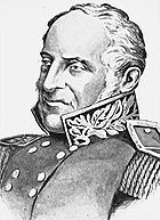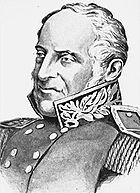
Roger Hale Sheaffe
Encyclopedia

United Kingdom
The United Kingdom of Great Britain and Northern IrelandIn the United Kingdom and Dependencies, other languages have been officially recognised as legitimate autochthonous languages under the European Charter for Regional or Minority Languages...
Army in the first part of the 19th century.
Early career
An American LoyalistLoyalist (American Revolution)
Loyalists were American colonists who remained loyal to the Kingdom of Great Britain during the American Revolutionary War. At the time they were often called Tories, Royalists, or King's Men. They were opposed by the Patriots, those who supported the revolution...
, Roger Hale Sheaffe was born in Boston, Massachusetts, the third son, and eighth child, of William Sheaffe, Deputy Collector of Customs, and his wife Susannah (née Child). William died in 1771, leaving at least ten children still living. Lord Percy, later 2nd Duke of Northumberland
Hugh Percy, 2nd Duke of Northumberland
Lieutenant-General Hugh Percy, 2nd Duke of Northumberland, FRS was an officer in the British army and later a British peer...
, aided the family during the American War of Independence, and sent young Roger to a military academy in London
London
London is the capital city of :England and the :United Kingdom, the largest metropolitan area in the United Kingdom, and the largest urban zone in the European Union by most measures. Located on the River Thames, London has been a major settlement for two millennia, its history going back to its...
. He helped support young Roger's military career, with the purchase of his first commission as ensign in 1778 in the 5th Regiment of Foot. He later purchased a Lieutenancy.
Sheaffe served with his regiment in Ireland from 1781 until 1787, when it was posted to Canada. In Detroit and at Fort Niagara, he served under Lieutenant Governor John Graves Simcoe
John Graves Simcoe
John Graves Simcoe was a British army officer and the first Lieutenant Governor of Upper Canada from 1791–1796. Then frontier, this was modern-day southern Ontario and the watersheds of Georgian Bay and Lake Superior...
, who had a high opinion of him. He was commissioned Captain in 1795. He first served under Lieutenant-Colonel Isaac Brock
Isaac Brock
Major-General Sir Isaac Brock KB was a British Army officer and administrator. Brock was assigned to Canada in 1802. Despite facing desertions and near-mutinies, he commanded his regiment in Upper Canada successfully for many years...
in the 49th Regiment of Foot in 1798; they served together in the campaign against the Batavian Republic
Batavian Republic
The Batavian Republic was the successor of the Republic of the United Netherlands. It was proclaimed on January 19, 1795, and ended on June 5, 1806, with the accession of Louis Bonaparte to the throne of the Kingdom of Holland....
in 1799 and in the Baltic
Baltic region
The terms Baltic region, Baltic Rim countries, and Baltic Rim refer to slightly different combinations of countries in the general area surrounding the Baltic Sea.- Etymology :...
in 1801.
The 49th was posted to Canada in 1802. As Lieutenant-Colonel, Sheaffe commanded the garrison at Fort George, where he faced an attempted mutiny. Despite his own notable achievements, Sheaffe was often compared unfavourably with the popular and charismatic Brock. Sheaffe had been Brock's second in command prior to their time in Canada, and continued in that role upon their arrival. Shortly after arriving at their new station, a mutiny was attempted by some of Sheaffe's men. Brock hurriedly came to the aid of his subordinate, ended the mutiny without conflict, and arrested the perpetrators. They claimed they took their actions directly as a result of Sheaffe's belligerence, but were subsequently executed after a court-martial. Brock warned Sheaffe to stop working the men too hard and to stop punishing men harshly for small infractions.
Sheaffe nevertheless attained the rank of Colonel in 1808, and Major-General in 1811. This last promotion actually hurt Sheaffe financially, as he transferred from a full-pay commission as Colonel of the 49th to half pay as an unassigned general officer on the staff.
War of 1812
Sheaffe returned to Canada from a visit to England in July 1812. The next month, the War of 1812War of 1812
The War of 1812 was a military conflict fought between the forces of the United States of America and those of the British Empire. The Americans declared war in 1812 for several reasons, including trade restrictions because of Britain's ongoing war with France, impressment of American merchant...
broke out. Sir George Prevost
George Prevost
Sir George Prévost, 1st Baronet was a British soldier and colonial administrator. Born in Hackensack, New Jersey, the eldest son of Swiss French Augustine Prévost, he joined the British Army as a youth and became a captain in 1784. Prévost served in the West Indies during the French Revolutionary...
, the Governor General of Canada and commander in chief of the forces there, appointed Sheaffe to command the troops at Fort George
Fort George, Ontario
Fort George National Historic Site is a historic military structure at Niagara-on-the-Lake, Ontario, that was the scene of several battles during the War of 1812...
on the Niagara River
Niagara River
The Niagara River flows north from Lake Erie to Lake Ontario. It forms part of the border between the Province of Ontario in Canada and New York State in the United States. There are differing theories as to the origin of the name of the river...
. While Brock was absent, dealing with an American army at the Siege of Detroit
Siege of Detroit
The Siege of Detroit, also known as the Surrender of Detroit, or the Battle of Fort Detroit, was an early engagement in the Anglo-American War of 1812...
, Sheaffe was required by Prevost to negotiate an armistice with the American forces on the opposite side of the river. Prevost may have believed that peace could be negotiated quickly, but by the time the armistice ended, the Americans had had been substantially reinforced.
Early on October 13 the Americans began crossing the Niagara at Queenston
Queenston, Ontario
Queenston is located 5 km north of Niagara Falls, Ontario in the Town of Niagara-on-the-Lake. The community is bordered by Highway 405 and the Niagara River; its location on the Niagara Escarpment led to the establishment of the now-defunct Queenston Quarry in the area...
, a few miles south of Fort George. Brock galloped from Fort George to Queenston, arriving just in time to see the Americans capture the commanding heights and a British heavy gun battery. He sent orders to Sheaffe to bring reinforcements, but before they could arrive he led two frontal assaults against the heights. During the second, he was shot dead. Sheaffe arrived on the battlefield at 2 p.m. In contrast to Brock's actions, he waited for reinforcements before leading his force on a wide detour to the top of the heights, so as to shield them from American artillery. He then meticulously drew up his force before attacking at 4 p.m. The Americans, terrified of the Mohawk
Mohawk nation
Mohawk are the most easterly tribe of the Iroquois confederation. They call themselves Kanien'gehaga, people of the place of the flint...
s who had also joined the battle, tried to flee but were trapped against the river, and surrendered. 1,000 prisoners were taken, for a cost of 50 casualties.
Sheaffe was appointed Lieutenant Governor and commander in Upper Canada in succession to Brock, but was unpopular with the people he was to defend, and often with his own soldiers. During the later months of 1812 he was unable to transact business with the Legislature due to illness and other military commitments, forcing Prevost to make a personal visit to Upper Canada in February 1813.
In April, Sheaffe was present in York, the provincial capital, to deal with the civil authorities. York was weakly defended and Sheaffe had only four companies of regulars, passing through on route to Fort George and other posts. On April 27, an American force supported by gunboats and other armed vessels attacked. In the Battle of York
Battle of York
The Battle of York was a battle of the War of 1812 fought on 27 April 1813, at York, Upper Canada . An American force supported by a naval flotilla landed on the lake shore to the west, defeated the defending British force and captured the town and dockyard...
, Sheaffe's outnumbered troops were driven back to the edge of the town. Sheaffe decided to preserve his regulars and ordered a retreat to Kingston
Kingston, Ontario
Kingston, Ontario is a Canadian city located in Eastern Ontario where the St. Lawrence River flows out of Lake Ontario. Originally a First Nations settlement called "Katarowki," , growing European exploration in the 17th Century made it an important trading post...
, having destroyed the fort and a sloop of war under construction in the dockyard. The militia were left to be taken prisoner, while the town was looted by the Americans and several buildings were set on fire.
Many prominent citizens of Upper Canada denounced Sheaffe's conduct at York, and Sir George Prevost relieved Sheaffe of his military and civil appointments in Upper Canada, putting him in charge of the troops in Montreal
Montreal
Montreal is a city in Canada. It is the largest city in the province of Quebec, the second-largest city in Canada and the seventh largest in North America...
.
Subsequent career
Later in the year, Sheaffe was recalled to Britain. Here he subsequently had a successful military career, being promoted to Lieutenant-General in 1821 and full General in 1835.He and his family lived in Penzance
Penzance
Penzance is a town, civil parish, and port in Cornwall, England, in the United Kingdom. It is the most westerly major town in Cornwall and is approximately 75 miles west of Plymouth and 300 miles west-southwest of London...
and Worcester
Worcester
The City of Worcester, commonly known as Worcester, , is a city and county town of Worcestershire in the West Midlands of England. Worcester is situated some southwest of Birmingham and north of Gloucester, and has an approximate population of 94,000 people. The River Severn runs through the...
, and he retired to Edinburgh
Edinburgh
Edinburgh is the capital city of Scotland, the second largest city in Scotland, and the eighth most populous in the United Kingdom. The City of Edinburgh Council governs one of Scotland's 32 local government council areas. The council area includes urban Edinburgh and a rural area...
. He died at his home in 36 Melville Street on 17 July 1851, and is buried in New Calton Cemetery, beside his daughters Frances Julia and Agnes Emily. He had been awarded a Baronetcy in January 1813 as a reward for the victory at Queenston Heights, but as none of his children survived him, the title died with him.
Family
Roger Hale Sheaffe married Margaret Coffin in Quebec in 1810. They had six children, all of whom predeceased their parents:- Frances Julia, b. 1812 in Canada, d. 1834 in Edinburgh.
- Agnes Isabella, b. 1814 in London, died in infancy.
- Agnes Emily, b. 1817 in Worcester, d. 1832 in Edinburgh.
- Percy, died as a young man.
- Another son and daughter who died in infancy.
External links
Sir Roger Hale Sheaffe - on Sheaffe Family Website by Paul Sheaffe

